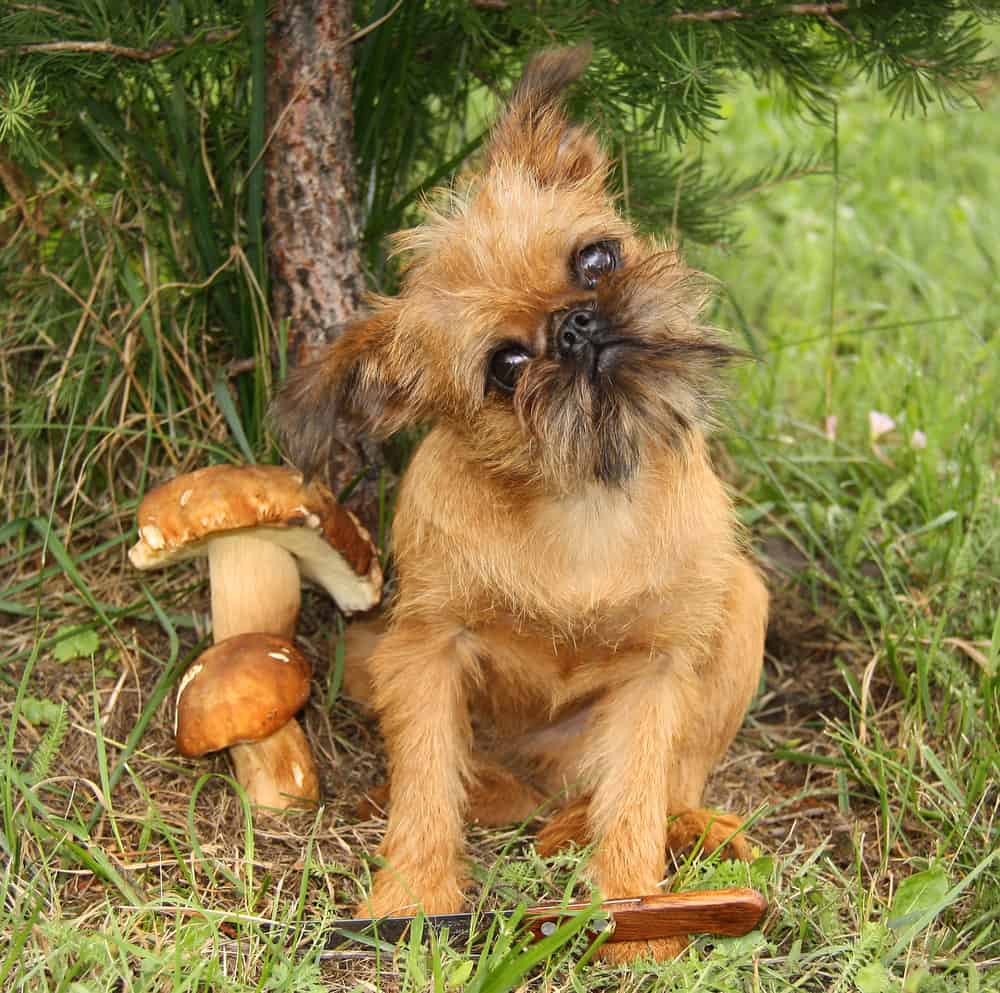It is a common habit to see dogs sniffing around things in your backyard or when having a walk. If you are not careful, the dog might end up eating some things without you realizing it. Things get even worse when your canine eats poisonous mushrooms in the yard, and you don’t know it in time.

Wild mushrooms thrive in deadwood and the base of some trees. So if you have deadwood in your yard, then expect to see wild mushrooms popping up most often. This might be bad news if you have a dog around that may eat the mushrooms. However, if the mushrooms are safe for human consumption, then you don’t need to worry about your pooch eating them.
Dogs can eat both raw and cooked mushrooms without any problem. But as mentioned, the mushrooms have to be safe for consumption. Because dogs consume raw mushrooms, be careful when having a walk with your canine in areas that might have some.
In this article, you will learn about safe mushrooms for your canine, what to do when your dog consumes unknown mushrooms, signs of poisoning, and the best tips to prevent poisoning in the first place. Let’s get started;
Which Types of Mushrooms Are Safe for Dogs to Eat?
Typically, mushrooms that are safe for human consumption are safe for dogs too. Most of these mushrooms are easy to grow and are commonly found in supplement stores near you. We have hundreds of edible mushrooms, but we will take a look at the common ones that your dog can eat comfortably.
Safe varieties of mushrooms that you can find in supplement stores or supermarkets include shiitake, white button, maitake, reishi, porcini, cremini, and portobello. These are just among the many edible mushrooms that you can find. If you suspect some mushroom species around your premises, experts recommend that you research it to determine whether it is safe for human consumption.
Signs that a Dog Ate Poisonous Mushroom
Dogs experience stomach upsets when they consume poisonous mushrooms. Toxic mushrooms can be grouped into different types based on the symptoms the dog exhibits. However, note that the signs and symptoms of mushroom poisoning vary depending on the type of mushroom your dog consumes.
Some poisonous mushrooms cause stomach upsets, while others may cause seizures, hallucinations, kidney failure, and tremors. Another group of mushrooms cause diarrhea, drooling and urination, tearing from eyes, and vomiting. So when you see these signs, then that might be mushroom poisoning.

What to Do If a Dog Eats Unknown Mushroom
It is normal to panic when you realize that your dog has eaten mushrooms and you are not sure whether they are poisonous or not. The first thing that comes to your mind is calling a veterinarian for advice. Yes! It is the best thing to do, but what if you can’t reach the veterinarian? Will you let your canine suffer or even die?
Unfortunately, it is relatively difficult to treat mushroom poisoning at home because of its severity. Any form of mushroom poisoning or toxicity should be treated quickly to avoid adverse effects.
Veterinarians suggest that making your dog throw up may save your dog’s life. So you must know easy steps on how to make your canine throw up when need be. But before then, you must understand there are times when vomiting is not an option.
So when is throwing up not an option? Well, as weird as it may sound, some dogs can swallow things that may prove dangerous if vomited. For example, small sharp objects may be hazardous to the throat of your dog if thrown up.
Caustic liquids may also be dangerous for your dog’s esophageal mucosa. Along that line, there are battery leakages. For example, if the dog chews a battery and then swallows it, forcing your dog to throw up may not be a good idea.
When is it right to induce vomiting on your dog, and what should you use? With poisoning, there is no time to waste. As long as vomiting is an option, then the process should be done as soon as possible. It is best to induce vomiting within two hours. If your dog vomits within thirty minutes or less, more than 50% of the toxins are removed.
Veterinarians use apomorphine to make your canine vomit. Unfortunately, this chemical is not readily available at home. So what should you use at home? Veterinarians recommend hydrogen peroxide at home because it is relatively safe for your canine, and it is readily available in many homes.
However, because hydrogen peroxide quickly degenerates over time, you must replace yours before the expiration date. Trying other methods like using salted water, alcohol, and gagging the dog with your finger may prove dangerous. For example, if you try reaching down the throat of your canine may result in a bite. So never try such methods.

Best Safety Tips for My Dogs While Hiking Around Wild Mushrooms
As aforementioned, mushroom poisoning should be taken seriously because of its effects. “Prevention is better than cure,” this is a common saying that may apply in this context. It is better to prevent mushroom poisoning than to try curing it. Keeping your canine away from mushroom poisoning threats is possible if you choose to be careful.
Here are the best and practical tips that may help you prevent mushroom poisoning when walking with your pet.
Check for Wild Mushrooms Around Your Yard
Wild mushrooms may be extremely dangerous for your pup to the extent they may lead to death. Dogs are different because some enjoy eating things that look interesting to them, while others take time before eating anything. But generally, dogs move around sniffing, and some wild mushrooms have appealing scents that may entice them.
If you suspect that wild mushrooms may thrive in your compound, carry it out through cleaning often. Trees like elm, oak, or generally dead wood encourage the growth of wild mushrooms. Consider doing away with deadwood to save you the energy and time of moving around each day.
Pay Close Attention to Your Dogs During Hikes
Paying close attention to your dog’s activities may help you notice when they consume something foreign. One of the best ways to do that is by ensuring your canine is walking ahead of you. Walking side by side is okay but do not allow your pup to walk behind you.
You may need to be extra careful with puppies because they are usually more playful than dogs. They can easily sneak and eat things, and before you realize it, they are back. When this happens, you may only notice if they consume something toxic. Unfortunately, if that happens, you can know it when the signs mentioned above begin to manifest.
Have Background Information on Mushrooms
As mentioned earlier, there are hundreds of mushrooms available worldwide, but those are exclusive to a given area. You may notice that some mushrooms pop up in your yard more often. Once you see that, you must get curious and learn about them. Be interested to know whether they are edible or not. If they are not edible, you need to come up with a strategy of getting them away from the yard.
It is also essential to have background information on some mushrooms you expect to see in your area. You can learn what they are likely to do and the severity of their poison if they are poisonous. Understand that there are edible mushroom look-alikes, and they should not confuse you. But if you are sure the mushrooms thriving in the yard are edible, no need to panic.
Train Your Dog to Drop Things from the Mouth
Dogs are among the animals that you can easily teach. With proper training, a dog can literally do things that people cannot imagine animals can do. The “drop it” cue is essential in this context because you can easily command your canine to drop anything.
Make sure the dog can perform that cue with a single command because it might be a lifesaver at some point. You can apply it when the dog puts something that you are not sure about in the mouth.
How to Safely Feed Mushrooms to Dogs
We already said that safe mushrooms for humans are safe for your dog too. They include those that you can buy from supplement stores or those grown by you in the garden. But what is the correct way to feed your canine with edible mushrooms?
The process is quite simple; it is a similar procedure to the one we practice at homes. Clean the mushroom to wash off any pesticides that might have come into contact with them. Prepare them like you usually do with other meals and then serve. It is as simple as that.
Final Thoughts
Dogs eat cooked and raw mushrooms alike. If a specific type of mushroom is safe for human consumption, it is equally safe for your canine. Never allow your dog to eat mushrooms that you are not sure about.
Rushing your canine to a veterinary clinic is the best option in case of mushroom poisoning. If that is not possible at the moment of the incident, you can try using hydrogen peroxide. Remember to check for the expiry date of hydrogen peroxide before offering it to your canine.




